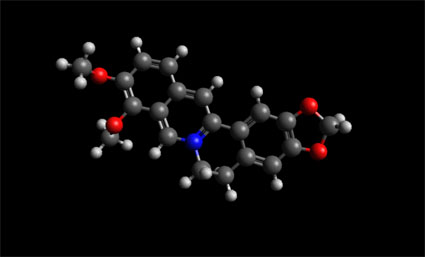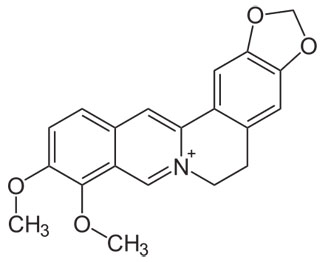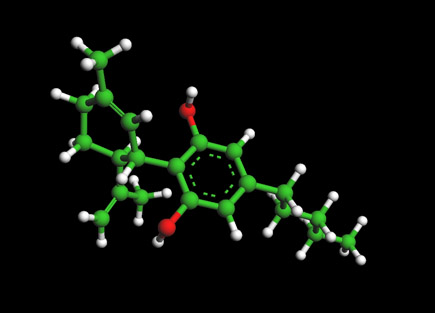Berberine as a Senolytic and Anti-Aging Molecule

Ball and Stick Model for Berberine Molecule
Berberine Molecule (above) Ball-and-stick. For 3D Jsmol File
Molecular formula -- C20H18NO4+
Molar mass --336.4 g/mol

Berberine molecular structure
What is Berberine?
Berberine is an organic heteropentacyclic compound, an alkaloid antibiotic, a botanical anti-fungal agent and a berberine alkaloid. ... Berberine is an alkaloid from Hydrastis canadensis L. , Berberidaceae. It is also found in many other plants. It has many chemical forms such as BBR hydrochloride, BBR sulfate, BBR citrate, and BBR phosphate. It has been used for thousands of years in traditional Chinese medicine to treat various diseases, such as infectious diseases and gastrointestinal disorders, without apparent side effects being reported from traditional use or from clinical use.
Berberine Bioactivity
As BBR has poor solubility and low oral bioavailability that impact BBR's efficacy, a number of laboratories and research groups have been developing novel oral delivery materials and creating new formulations aimed at improving BBR's bioavailability.
ABSTRACTS
1 DECEMBER 2017 Rhizoma Coptidis and Berberine as a Natural Drug to Combat Aging and Aging-Related Diseases via Anti-Oxidation and AMPK Activation
Aging is the greatest risk factor for human diseases, as it results in cellular growth arrest, impaired tissue function and metabolism, ultimately impacting life span. Two different mechanisms are thought to be primary causes of aging. One is cumulative DNA damage induced by a perpetuating cycle of oxidative stress; the other is nutrient-sensing adenosine monophosphate-activated protein kinase (AMPK) and rapamycin (mTOR)/ ribosomal protein S6 (rpS6) pathways. As the main bioactive component of natural Chinese medicine rhizoma coptidis (RC), berberine has recently been reported to expand life span in Drosophila melanogaster, and attenuate premature cellular senescence. Most components of RC including berberine, coptisine, palmatine, and jatrorrhizine have been found to have beneficial effects on hyperlipidemia, hyperglycemia and hypertension aging-related diseases. The mechanism of these effects involves multiple cellular kinase and signaling pathways, including anti-oxidation, activation of AMPK signaling and its downstream targets, including mTOR/rpS6, Sirtuin1/ forkhead box transcription factor O3 (FOXO3), nuclear factor erythroid-2 related factor-2 (Nrf2), nicotinamide adenine dinucleotide (NAD+) and nuclear factor-κB (NF-κB) pathways. Most of these mechanisms converge on AMPK regulation on mitochondrial oxidative stress. Therefore, such evidence supports the possibility that rhizoma coptidis, in particular berberine, is a promising anti-aging natural product, and has pharmaceutical potential in combating aging-related diseases via anti-oxidation and AMPK cellular kinase activation.see full publication
13 March 2018 Berberine hydrochloride inhibits cell proliferation and promotes apoptosis of non-small cell lung cancer via the suppression of the MMP2 and Bcl-2/Bax signaling pathways
Berberine, also known as berberine hydrochloride and isoquinoline alkaloid, is a major alkaloid from Coptis chinensis. Berberine's extensive biological properties have previously been studied, and it has been used clinically for the treatment of diarrhea, hypertension, diabetes and other diseases. The present study aimed to determine the possible anticancer effects of berberine hydrochloride treatment on human non-small cell lung cancer (NSCLC) cell proliferation and apoptosis via the matrix metalloproteinase 2 (MMP-2) and the B-cell lymphoma 2 (Bcl-2)/Bcl-2-associated X protein (Bax) signaling pathway. Human A549 lung carcinoma cells were exposed to various concentrations of berberine hydrochloride in order to analyze the possible anticancer effects on NSCLC cell proliferation and apoptosis, using a MTT assay and an Annexin V-fluorescein isothiocyanate/propidium iodide apoptosis kit. Subsequently, the present study detected the expression of MMP-2, Bcl-2, Bax and Janus kinase 2 (Jak2). Berberine hydrochloride treatment inhibited the expression of vascular endothelial growth factor (VEGF) and nuclear factor κB (NF-κB) and transcription factor AP-1 (AP-1) proteins, in A549 cells. Firstly, it was revealed that berberine hydrochloride treatment may inhibit proliferation, increase cytotoxicity and enhance apoptosis in A549 cells. Subsequently, treatment with berberine hydrochloride significantly downregulated MMP-2 protein expression, increased the activity of the Bcl-2/Bax signaling pathway and suppressed the Jak2/VEGF/NF-κB/AP-1 signaling pathways. These results suggest that berberine hydrochloride may be a potential novel anticancer drug, since it inhibits cell proliferation and promotes the rate of apoptosis of NSCLC cells by the suppression of the MMP-2, Bcl-2/Bax and Jak2/VEGF/NF-κB/AP-1 signaling pathways. Keywords: berberine hydrochloride, non-small cell lung cancer, matrix metalloproteinase 2, B-cell lymphoma 2/B-cell lymphoma 2-associated X protein... see full publicaton
11 September 2017 Metformin and berberine, two versatile drugs in treatment of common metabolic diseases
Metformin has been used as a glucose lowering drug for several centuries and is now a first-line drug for type 2 diabetes mellitus (T2DM). Since the discovery that it activates AMP-activated protein kinase (AMPK) and reduces risk of cancer, metformin has drawn great attentions. Another drug, berberine, extracted from berberis vulgaris L. (root), was an ancient herbal medicine in treating diarrhea. Ongoing experimental and clinical studies have illuminated great potential of berberine in regulation of glucose and lipid homeostasis, cancer growth and inflammation. Furthermore, the lipid lowering effect of berberine is comparable to those conventional lipid drugs but with low toxicity. Therefore, it is right time to transform beneficial effects of berberine into therapeutic practice. Metformin and berberine share many features in actions despite different structure and both could be excellent drugs in treating T2DM, obesity, cardiac diseases, tumour, as well as inflammation. Since these disorders are often connected and comprise common pathogenic factors that could be targeted by the two drugs, understanding their actions can give us rationale for expansion of their clinical uses. Keywords: metformin, berberine, metabolic diseases, tumour...see full publication
06 August 2019 An Insight Into the Molecular Mechanism of Berberine Towards Multiple Cancer Types Through Systems Pharmacology
Over the past several decades, natural products with poly-pharmacological profiles have demonstrated promise as novel therapeutics for various complex diseases, including cancer. Berberine (PubChem CID: 2353), a soliloquies quaternary alkaloid, has been validated to exert powerful effects in many cancers. However, the underlying molecular mechanism is not yet fully elucidated. In this study, we summarized the molecular effects of berberine against multiple cancers based on current available literatures. Furthermore, a systems pharmacology infrastructure was developed to discover new cancer indications of berberine and explore their molecular mechanisms. Specifically, we incorporated 289 high-quality protein targets of berberine by integrating experimental drug–target interactions (DTIs) extracted from literatures and computationally predicted DTIs inferred by network-based inference approach. Statistical network models were developed for identification of new cancer indications of berberine through integration of DTIs and curated cancer significantly mutated genes (SMGs). High accuracy was yielded for our statistical models. We further discussed three typical cancer indications (hepatocarcinoma, lung adenocarcinoma, and bladder carcinoma) of berberine with new mechanisms of actions (MOAs) based on our systems pharmacology framework. In summary, this study systematically provides a powerful strategy to identify potential anti-cancer effects of berberine with novel mechanisms from a systems pharmacology perspective... see full publication
31 January 2019 Berberine can be the next big thing in natural sugar regulation
Article Summary: --Maintaining healthy and consistent blood sugar levels is critical for optimal well-being.--Maitake mushrooms and cinnamon have been shown to effectively decrease blood sugar.-- Berberine supplementation may be the most promising method of natural blood sugar due to its ability to keep patients within a stable and healthy range by both decreasing high blood sugar and addressing low blood sugar
Anti-Aging and Senolytics Home Page
- What is Anti-Aging Medicine
- What is Senescence?
- What are Senolytics?
- About Caloric Restriction
- Mtor and Rapamycin
- The IKK/NF-κB signaling pathway in aging
- Exercise and Anti-Aging
- Meditation and Anti-Aging
SENOLYTIC AND ANTI-AGING MOLECULES
RAPAMYCIN ---The mechanistic target of rapamycin (mTOR) pathway has a central role in cell activation...
METFORMIN -- The diabetes drug metformin used by some for anti-aging may diminish benefits of aerobic exercise...
QUERCETIN-- AND WITH DASATINIB--The senolytic cocktail, dasatinib plus quercetin, which causes selective elimination of senescent cells...
FISETIN--Of the 10 flavonoids tested, fisetin was the most potent senolytic...
EGCG- The most active component of green tea....
NAD BOOSTERS --'...The cells of the old mice were indistinguishable from the young mice, after just one week of treatment...
SULFORAPHANE-- An isothiocyanate present in cruciferous vegetables activates antioxidant and anti-inflammatory responses by ...
UROLITHIN --Metabolite of Pomegranate compound with anti-aging effects passes human trial...
MITO-Q -- A water soluble fomr of CoQ10 that has excellent absorption and high bioavailability...
HONOKIOL - A bioactive natural product derived from Magnolia Bark have demonstrated ...
CURCUMIN AND ANALOGS -Recent research is focused on the design and synthesis of curcumin analogs as antiproliferative and anti-inflammatory agents...
BERBERINE --berberine has recently been reported to expand life span in Drosophila melanogaster, and attenuate premature cellular senescence
N-ACETYL-CYSTINE (NAC)--"...pretreatment with NAC increased glutathione levels in the older cells and largely helped offset that level of cell death..."
PIPERLONGUMINE - A natural product from the Long pepper with high bioavailability...
RESVERATROL AND PTEROTSILBINE -- Pterostilben chemically similar to resveratrol bute differs from resveratrol by exhibiting increased bioavailability (80% compared to 20% in resveratrol)
SPERMIDINE--Spermidine delays aging in humans ...
ALLICIN -- Allicin is a compound produced when garlic is crushed or chopped. ...
VITAMIN D3 -- Production of the active forms of Vitamin D are reduced by 50% as a result of an age-related decline
VITAMIN K-- evidence suggests vitamin K has an anti-inflammatory action
TOCOTRIENOL(AND WITH QUERCETIN) --Tocotrieniols have been found to exert a synergistic antitumor effect on cancer cells when given in combination....
HSP-90 INHIBITORS --As a novel class of senolytics
The Cannabidiol Molecule
Cannabidiol (CBD is the major non-psychoactive component of Cannabis and is being looked at by major drug and consumer companies for various medical and social uses.